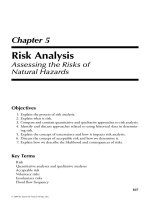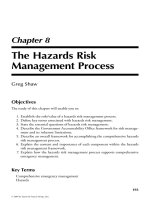Trend Forecasting With Technical Analysis Chapter 6 potx
Bạn đang xem bản rút gọn của tài liệu. Xem và tải ngay bản đầy đủ của tài liệu tại đây (70.69 KB, 6 trang )
NEURAL NETWORKS
How to Raise Your Financial IQ to
Stay Ahead of the Competition
T
he human brain is composed of hundreds of billions of cells
known as neurons, which through their connections to each
other relay information from one neuron to another. This pro-
cess allows a person to learn relationships, draw inferences, recog-
nize patterns and make predictions, among other tasks. While sub-
stantially less complex than the human
brain, neural networks model how it
processes information and performs
pattern recognition and forecasting.
Neural networks are comprised of
individual neurons organized in layers
and interconnected through network
architecture with variable mathematical
weights attributed to each connection.
The architecture includes an input layer,
hidden layer and an output layer.
Neural networks are excellent at sift-
ing through enormous amounts of seem-
ingly unrelated market data and finding
repetitive patterns that could never be
perceived visually just by looking at
price charts or by comparing two markets to one another. Through a
mathematical error minimization process known as “learning” or
“training,” neural networks, if designed properly, can be trained to
make highly accurate market forecasts based upon these patterns.
Trend Forecasting With Technical Analysis 93
Chapter 6
Neural networks
are excellent at
sifting through
enormous amounts
of seemingly unre-
lated market data
and finding repeti-
tive patterns that
could never be
perceived visually
just by looking at
price charts or by
comparing two mar-
kets to one another.
FIGURE 6-1. VANTAGEPOINT’S NEURAL NETWORKS MAKE MARKET FORECASTS
Source: Market Technologies Corporation
94 Trade Secrets
Neural Networks Combine Technical and
Intermarket Data
VantagePoint’s neural networks are designed and trained to make
specific forecasts for each target market. The raw input data from the
target market and related markets, statistical “preprocessing” of the
raw data, network architecture, as well as the training and testing reg-
imens are tailored to each target market.
Figure 6-1 depicts how single-market technical data from a target
market and intermarket data from related markets are fed into
VantagePoint’s neural networks to make predictions for each of the
twenty-five target markets that VantagePoint monitors each day.
Like back-testing and optimization a decade earlier, neural net-
works at first had their skeptics and detractors in the financial indus-
try in the early 1990s, around the time the first version of Vantage-
Point was released. Software developers from outside of the financial
industry, knowledgeable about neural networks applied to other are-
nas and perceiving a potentially lucrative marketplace for their soft-
ware among traders, flooded into the financial industry offering an
assortment of neural network software programs to traders. Before
long neural networks were being hyped in promotional marketing lit-
erature as the Holy Grail of technical analysis as expectations about
their potential reached dizzying heights.
Single-market technical data and intermarket data from related markets are fed into
VantagePoint’s neural networks to make forecasts for the target market.
Data From
Target Market
Data From
Related
Markets
Neural
Networks
Goal
Trend
Forecasts
and
Price
Forecasts
Unfamiliar with the intricacies of the financial markets and the
details underlying technical analysis, many of these newcomers to the
financial industry helped foster a backlash against neural networks
among traders as the Holy Grail remained elusive.
My focus, though, since the mid-1980s has been intermarket analy-
sis. Neural networks just happen to be the best mathematical tool that
I have identified for finding hidden patterns and relationships in
seemingly disparate market data and making highly accurate short-
term market forecasts in a non-subjective, quantitative manner. Neural
networks are not a magic bullet. They are the means, not the end.
Neural Networks Learn Patterns and Make
Forecasts
Over the past decade since first appearing on the financial indus-
try scene, neural networks have been applied successfully to finan-
cial forecasting, corporate decision-making (including risk analysis
and fraud detection), character recognition and medical diagnostics,
to name a few application areas.
Recently with prominent software companies developing and pro-
moting neural network software for decision analysis such as Com-
puter Associates International’s Neugents
™
software, neural networks
have become more accepted as a mainstream mathematical tool.
The Input Layer
A neural network is not limited to single-market technical data
inputs. A neural network is excellent at applying intermarket data (as
well as fundamental data) to market forecasting.
For instance, for a neural network designed to forecast New York
Light Crude Oil, the analysis includes ten years of past price, volume
and open interest data on crude oil futures.
The analysis also includes the following intermarket inputs: crude
oil cash, the Bridge/CRB Futures Price Index, the S&P 100, Comex
gold, Comex silver, the Japanese yen, N.Y. heating oil #2, Treasury
bonds and the U.S. Dollar Index. Additionally, fundamental data in-
puts can be incorporated. Once the raw input data has been select-
ed, it is preprocessed using various algebraic and statistical methods
of transformation, in order to facilitate learning.
Trend Forecasting With Technical Analysis 95
96 Trade Secrets
The Hidden Layer
The hidden layer is used by a neural network for internal process-
ing to store its “intelligence” during the learning process. This layer is
composed of neurons where the network recodes the input data into
a form that captures hidden patterns and relationships. The network
generalizes from previously learned facts to new inputs, which allows
it to make its forecasts. The number of neurons in the hidden layer
and the number of hidden layers are determined through experi-
mentation.
The Output Layer
The output layer is where a network’s forecasts are made. Two
types of real number outputs in financial analysis include forecasts of
prices such as the next day’s high and low, and forecasts of technical
indicators such as a predicted 5-day moving average value for two
days in the future. Decisions must be made about not only what out-
put to forecast, but also how far into the future to make the forecast.
Learning Algorithms
There are many different learning algorithms that can be used to
train a neural network. Each algorithm has different performance
characteristics. All of the algorithms attempt to minimize the overall
error in the network’s forecasts.
One popular learning algorithm is the gradient-descent algorithm.
However, gradient-descent trains slowly and often finds sub-optimal
solutions. This limitation is similar to pitfalls encountered with back-
testing and optimization of rule-based trading strategies in which sub-
optimal sets of parameter values are found that are isolated and
unstable.
How a Neural Network Learns
Training a neural network involves a repetitive mathematical
process in which the neural network learns underlying hidden pat-
terns, discerns leads and lags and identifies nonlinear relationships
within the data from repeated exposures to the input data. Learned
information is stored by the network in the form of a weight matrix,
with changes in the weights occurring as the network “learns.” Similar
to the learning process people engage in, a neural network learns
patterns by being exposed to repeated examples of them. Then the
neural network generalizes through the learning process to related
but previously unseen patterns.
One popular network paradigm that has been used for financial
market analysis and forecasting is known as a “feed-forward” network
that trains through “back-propagation of error” which is depicted in
Figure 6-2.
Once trained, a neural network acts as a market forecasting tool,
allowing traders to achieve the trend identification and forecasting
goals of technical analysis.
Trend Forecasting With Technical Analysis 97
FIGURE 6-2. SIMPLE FEED-FORWARD BACK-PROPAGATION NEURAL NETWORK
Source: Market Technologies Corporation
A simple feed-forward back-propagation network, using technical and intermarket
data as inputs, trains by back-propagation of error throughout the network.
Trend Forecasts
Back
Propagation
of Error
Output
Hidden
Input
Input Data From Target Market and
Related Markets
98 Trade Secrets
Overtraining Is Not Desirable
Overtraining a neural network must be avoided. Overtraining
occurs when a neural network memorizes the subtleties and idio-
syncrasies particular to specific training data, without developing the
capacity to generalize to new data. Overtraining is analogous to
curve-fitting or over-optimization when performing back-testing and
optimization on rule-based trading strategies. An overtrained network
will perform poorly on out-of-sample test data and subsequently
when making its forecasts during realtime trading.
How a Neural Network Is Tested for Accuracy
Testing is performed by creating an independent test file made up
of data that had not been seen by a neural network during the train-
ing process. In the testing mode the neural network is given these
new inputs and utilizes the representation that it had previously
learned to generate its forecasts. This allows the network to be eval-
uated under simulated trading conditions. This is analogous to “walk-
forward” or “out-of-sample” testing of rule-based trading strategies.
Performance results from various neural networks on test data can
be compared prior to making a determination about which specific
neural network to select for use in the final application. Depending
on the comparative test performance results, changes often need to
be made in the selection of input data, preprocessing, network archi-
tecture, etc., and retraining conducted before the final application
network is selected.
There’s More to Neural Networks
There are similarities and differences between designing and train-
ing a neural network and developing and testing rule-based trading
strategies. If you want to learn more about the technical details and
underlying mathematics behind neural networks, I refer you to my
personal website www.FutureForecasts.com which includes reprints
of many of the research articles and book chapters I have previous-
ly written about the application of neural networks to technical analy-
sis and market forecasting.









